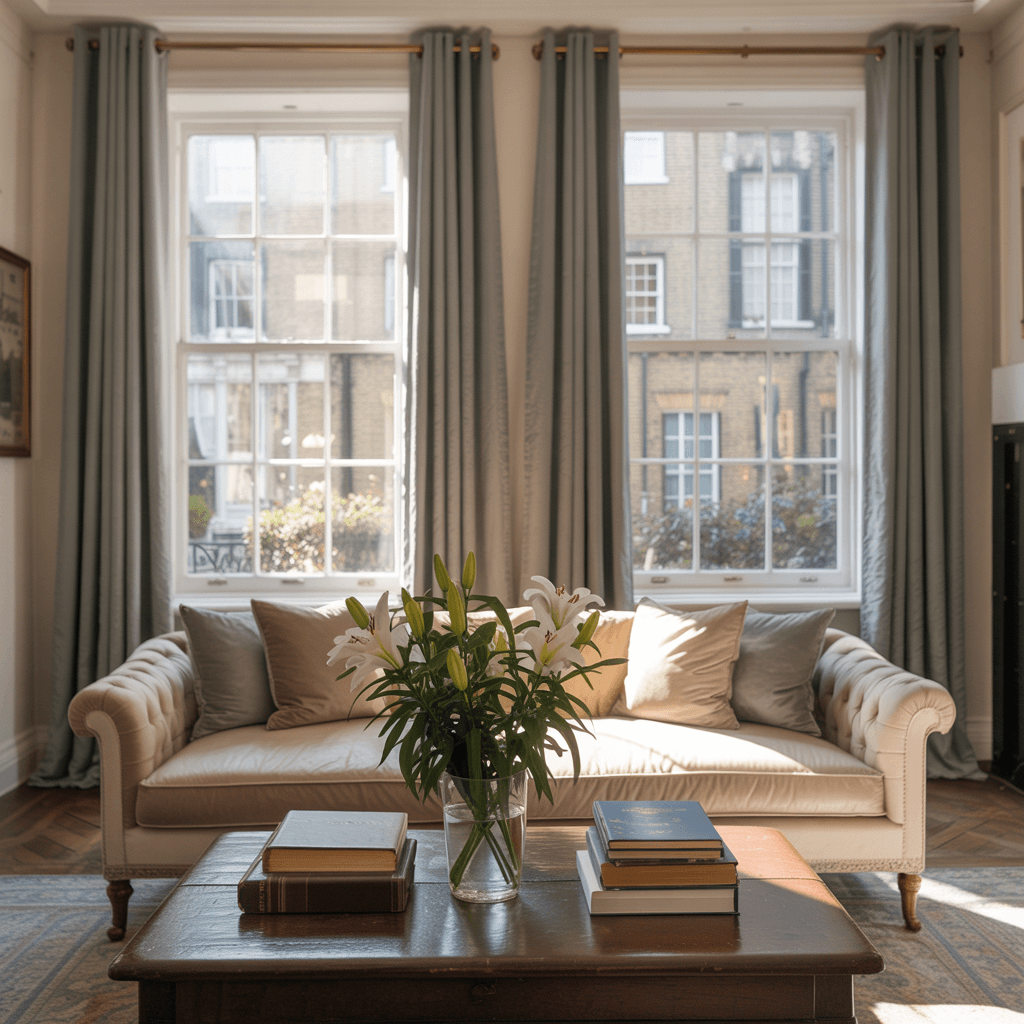The Rising Demand for Sustainable Sash Windows
The architectural landscape is shifting, and with it, the expectations placed upon those who design, restore, and retrofit the built environment. As sustainability becomes a defining pillar of modern architecture, the materials chosen for new builds and heritage restorations alike must meet an evolving set of ecological, regulatory, and aesthetic demands. Timber sash windows, long considered a hallmark of classic British architecture, are now at the center of this conversation—offering a unique intersection of tradition and sustainability.
For architects working with listed buildings, conservation areas, and period properties, specifying sash windows is no straightforward task. Conservation officers demand historical accuracy, clients seek high-performance solutions, and regulatory bodies continue to introduce stricter energy efficiency and carbon reduction targets. At the same time, many misconceptions persist regarding the sustainability of timber versus uPVC, leading to hesitancy in choosing a material that, when sourced and manufactured responsibly, is arguably one of the most sustainable options available.
This guide, developed with the expertise of London Sash Window Experts, unpacks the complexities of specifying sustainable timber sash windows in a way that aligns with both conservation principles and the modern expectations of energy efficiency and net-zero compliance. We will explore the key challenges architects face, including the regulatory landscape, material selection, performance expectations, and procurement logistics. More importantly, we will provide practical, actionable insights to ensure that every sash window specified is not only aesthetically faithful to its historical roots but also contributes meaningfully to a low-carbon, future-ready built environment.
As demand for sustainable building solutions grows, the industry must reconcile the past with the future—ensuring that traditional craftsmanship does not become obsolete in the pursuit of innovation. By making informed, strategic choices about materials, glazing, airtightness, and lifecycle performance, architects can elevate their projects, meeting and exceeding both heritage and sustainability criteria.
The future of sustainable sash windows is not just about compliance—it’s about redefining standards, preserving architectural heritage, and creating enduring, high-performance structures. With the right knowledge, tools, and partnerships—such as those offered by London Sash Window Experts—architects can position themselves at the forefront of this necessary transformation.
The Sustainability Challenges Architects Face

Sustainability in architecture is no longer an abstract ideal; it is a structural and material imperative. Yet, for architects working with heritage buildings and period properties, balancing aesthetic integrity, conservation regulations, and sustainability targets presents a significant challenge. Nowhere is this tension more apparent than in the specification of timber sash windows, where tradition and innovation must seamlessly coexist.
At the core of this challenge is the regulatory landscape, which can be contradictory. The UK’s Part L energy efficiency requirements push for high-performance materials, while heritage conservation laws demand historically accurate replacements. This creates a difficult scenario: how can an architect specify a sash window that meets modern performance standards while adhering to strict conservation rules?
Timber, when ethically sourced and properly treated, is an inherently sustainable material, but its supply chain presents challenges that architects must navigate:
- Legitimacy & Certification – Greenwashing and ambiguous sourcing claims make it difficult to ensure timber is genuinely FSC or PEFC-certified.
- Embodied Carbon vs. Operational Performance – Conservation authorities often fixate on appearance, overlooking the carbon storage potential and sustainability benefits of well-sourced timber.
- Lead Times & Availability – Sustainable timber takes longer to source than mass-produced alternatives like uPVC, creating logistical hurdles for tight project timelines.
Architects must also contend with misconceptions about durability and maintenance. There is a persistent narrative that uPVC is the more practical choice, despite its reliance on petrochemicals, limited lifespan, and downcycling challenges. This perception can lead to resistance from clients and contractors, requiring architects to present a compelling, data-backed case for timber’s long-term economic and environmental benefits.
The role of an architect is not just to specify materials but to shape the future of sustainable heritage design. By working with trusted partners like London Sash Window Experts, architects can ensure their projects meet both aesthetic and ecological benchmarks, while advancing the discourse on sustainability in historic architecture.
Timber vs. uPVC – The Real Sustainability Debate
The debate between timber and uPVC sash windows is often framed as a choice between tradition and convenience, but this binary framing obscures the deeper environmental, economic, and design implications. For architects committed to sustainability and material integrity, the challenge is not simply selecting a material but understanding its long-term lifecycle impact—a critical distinction in an era where embodied carbon calculations are shaping regulatory frameworks and design ethics.
At first glance, uPVC appears to be the practical choice: it is mass-produced, affordable, and marketed as low-maintenance. However, this convenience comes at an environmental cost:
- Fossil Fuel Dependency – uPVC is derived from polyvinyl chloride, a petroleum-based plastic that requires extensive chemical processing and energy consumption.
- Downcycling, Not Recycling – Unlike timber, which can be reused, repaired, or biodegraded, uPVC is typically downcycled, meaning that each iteration results in a lower-grade material with limited future applications.
- Disposal & Microplastics – Aged uPVC degrades, releasing toxic microplastics into the environment, while timber, at the end of its lifespan, returns to the earth without ecological harm.
By contrast, sustainably sourced timber sash windows align with carbon sequestration principles and regenerative material use:
- Carbon Capture & Storage – Timber absorbs and locks away carbon dioxide during its growth cycle, contributing to net-zero construction strategies.
- Repairability & Lifespan – High-quality timber sash windows last over 50 years with proper maintenance, whereas uPVC units degrade, discolor, and warp within 15-30 years.
- Circular Economy Integration – End-of-life timber can be repurposed, reclaimed, or biodegraded, ensuring it never becomes waste in the way uPVC inevitably does.
The resistance to specifying timber often stems from outdated perceptions regarding maintenance and durability, but with modern weatherproof coatings, thermally modified woods, and airtight glazing, timber sash windows now outperform uPVC in both longevity and energy efficiency.
By choosing timber, architects are not merely selecting a material—they are making a strategic investment in sustainability, architectural integrity, and the future of regenerative design. Working with London Sash Window Experts, architects gain access to certified, conservation-approved timber and tailored solutions that preserve heritage while exceeding contemporary performance standards.
How to Specify Sustainable Timber Sash Windows

Specifying sustainable timber sash windows is not simply a question of material selection—it is an exercise in architectural foresight, environmental responsibility, and regulatory navigation. Architects must balance aesthetic fidelity, performance expectations, and sustainability objectives, ensuring that every specification aligns with heritage constraints, lifecycle carbon targets, and modern energy efficiency standards.
1. Timber Selection – The Foundation of Sustainability
The sustainability of timber extends beyond its raw material properties—its source, treatment, and longevity determine its true environmental impact. Architects must specify:
- FSC or PEFC-Certified Timber – Ensures responsible forestry, carbon sequestration benefits, and compliance with UK & EU sustainability laws.
- Durable & Low-Maintenance Species – Accoya (modified softwood) offers exceptional longevity, while European oak provides high structural integrity.
- Weather-Resistant Treatments – Factory-applied coatings enhance rot resistance, UV stability, and moisture protection, reducing long-term maintenance demands.
2. Glazing & Thermal Performance – The Intersection of Heritage & Efficiency
In conservation areas, glazing selection is often the most contentious specification challenge. To achieve both historical authenticity and energy efficiency, architects should consider:
- Slimline Vacuum-Glazing – Ultra-thin double-glazing solutions that comply with heritage standards while significantly reducing heat loss.
- Low-E (Low-Emissivity) Coatings – Reflects interior heat back inside the building, improving U-values without altering aesthetic clarity.
- Draught-Sealing Enhancements – Traditional weight-and-pulley sash windows can now incorporate airtight brush seals to prevent thermal leakage.
3. Detailing for Longevity & Passive Performance
A well-specified sash window is not just an aesthetic feature—it is a passive performance system that enhances both energy efficiency and occupant comfort. Architects should:
- Incorporate Thermal Breaks in Timber Frames – Prevents cold bridging and improves the window’s overall energy performance.
- Ensure Airtight Installation – Proper perimeter sealing and window junction detailing prevent unintended air infiltration.
- Validate with Whole-Building Performance Models – Use PHPP (Passive House Planning Package) to ensure sash windows contribute positively to net-zero energy goals.
By working with London Sash Window Experts, architects can access bespoke conservation-approved solutions that integrate seamlessly into both traditional restorations and contemporary sustainable builds. The success of a sustainable sash window specification is measured not just in its visual harmony, but in its ability to endure, perform, and contribute to a regenerative architectural future.
Performance & Energy Efficiency – Overcoming Client Resistance
Architects specifying timber sash windows must frequently bridge the gap between heritage aesthetics and modern performance expectations. While clients prioritize energy efficiency and long-term cost savings, many remain skeptical about timber’s ability to meet the airtightness and thermal performance of modern alternatives. Overcoming this resistance requires more than just data—it demands a compelling, evidence-backed narrative that reframes timber sash windows as an energy-efficient, future-proof investment.
1. The Airtightness Misconception – Why Timber Sash Windows Are Not ‘Leaky’
Historic sash windows earned a reputation for draughtiness, but this perception is rooted in legacy installations, not modern performance standards. Today’s high-performance timber sash windows incorporate:
- Precision Draught Sealing – Integrated brush seals and compression gaskets ensure airtight operation without compromising functionality.
- Factory-Finished Frames – Modern sash windows use engineered timber, reducing natural expansion and contraction while maintaining structural stability.
- Double-Compression Locking Systems – Prevents air infiltration at meeting rails, significantly improving air permeability ratings.
When properly installed and detailed, timber sash windows can meet or exceed Part L air permeability requirements, rivaling high-spec casement alternatives.
2. Glazing & Thermal Efficiency – Aligning Conservation with Performance
While traditional single glazing struggles to retain heat, advanced glazing options now elevate sash windows to modern performance standards:
- Vacuum-Insulated Glazing (VIG) – Delivers U-values as low as 0.4 W/m²K, outperforming standard double-glazing in heat retention.
- Low-E Coatings & Krypton-Filled Cavities – Reduce radiative heat loss while maintaining aesthetic transparency.
- Thermal Break Technology in Timber Frames – Prevents cold bridging, boosting overall window performance.
3. Long-Term Energy Savings vs. Short-Term Costs
Clients often resist timber due to perceived higher upfront costs, overlooking the lifecycle benefits:
- 50+ Year Lifespan – Well-maintained timber sash windows outlast uPVC, reducing replacement costs.
- Lower Heating Bills – Improved airtightness and glazing efficiency translate into lower operational energy demands.
- Resale Value Enhancement – Properties with heritage-appropriate, high-performance timber windows maintain higher market desirability.
By working with London Sash Window Experts, architects can deliver bespoke solutions that satisfy both conservation officers and energy-conscious clients. The evolution of timber sash windows is not about compromise—it’s about redefining what sustainability and performance look like in heritage architecture.
Procurement & Lead Time Challenges – Avoiding Project Delays

Sourcing sustainable timber sash windows requires meticulous supply chain coordination, certification verification, and proactive scheduling. Unlike mass-produced alternatives, high-performance timber sash windows undergo a specialized manufacturing and finishing process, making procurement a strategic priority rather than a last-minute order.
1. The Reality of Lead Times – Why Sustainable Timber Takes Longer
Architects specifying timber sash windows must account for longer production cycles, influenced by:
- Sustainable Forestry & Certification Processes – FSC and PEFC-certified timber is harvested under strict ecological guidelines, ensuring responsible forestry but extending procurement timelines.
- Bespoke Manufacturing & Conservation Approvals – Custom-made sash windows require heritage compliance checks, extending design-to-installation periods.
- Drying & Treatment Phases – Engineered timber undergoes moisture control, weatherproof treatments, and precision finishing, adding weeks to production schedules.
Failing to account for these variables leads to costly project delays, forcing architects to choose inferior, non-certified materials under time constraints.
2. Strategies to Reduce Lead Times Without Sacrificing Sustainability
To ensure project timelines remain on track, architects must adopt a preemptive procurement strategy:
- Early Specification & Supplier Engagement – Collaborating with specialists like London Sash Window Experts at the design stage prevents last-minute compromises.
- Batch Ordering for Multi-Phase Developments – Locking in bulk orders early mitigates supply chain disruptions and price volatility.
- Prioritizing UK & European Timber Sources – Localized sourcing reduces transportation emissions while ensuring compliance with UK building standards.
3. Verifying Supply Chain Integrity – Ensuring Ethical Sourcing
Beyond avoiding delays, architects must also safeguard material integrity and regulatory compliance:
- Demand Full Chain-of-Custody Documentation – Ensures timber is traceable from forest to fabrication.
- Assess Factory Capacity & Lead Time Commitments – Choose manufacturers with transparent production schedules to mitigate unforeseen setbacks.
- Confirm Conservation Officer Approval Timelines – Engage heritage bodies early to avoid regulatory bottlenecks.
By working with London Sash Window Experts, architects gain access to reliable supply networks and pre-approved heritage-compliant solutions, preventing delays, cost overruns, and sustainability compromises.
The success of a project is not just in the design—it’s in the execution. Proactively managing procurement logistics ensures that specifying sustainable timber sash windows is not an obstacle, but a strategic advantage.
Specifying Timber Sash Windows for Net-Zero & Passive House Projects
Achieving Net Zero and Passive House certification demands an approach where every material, junction, and detail is optimized for thermal efficiency, airtightness, and lifecycle sustainability. Traditionally, sash windows were seen as a heritage feature rather than a high-performance component—but with modern advancements in timber treatment, glazing, and air-sealing technologies, they are now a viable option for low-energy buildings.
1. Thermal Performance – Optimizing U-Values & Airtightness
Passive House design requires U-values below 0.8 W/m²K, a benchmark many architects assume is unattainable with sash windows. However, London Sash Window Experts integrate the latest glazing and frame technologies to ensure high thermal resistance without compromising aesthetics:
- Vacuum-Insulated Glazing (VIG) – Delivers U-values as low as 0.4 W/m²K, making sash windows competitive with high-performance casements.
- Thermal Break Integration – Timber frames with engineered insulating cores minimize cold bridging and heat loss.
- Double-Compression Weather Seals – Enhances airtightness without restricting sash movement, addressing Passive House air permeability requirements.
2. Airtightness & Passive Ventilation – Eliminating Thermal Leakage
While historic sash windows were notoriously draughty, today’s high-performance detailing ensures they contribute positively to airtight building envelopes:
- Multi-Layered Sealing Systems – Secondary & tertiary brush seals maintain a tight air barrier while allowing smooth sash operation.
- MVHR (Mechanical Ventilation with Heat Recovery) Integration – Prevents condensation issues and supports optimized air exchange rates.
- Frame-to-Wall Junction Detailing – Uses expanding foam tapes, insulated linings, and precision-installed reveals to eliminate weak points.
3. Material Sustainability – Closing the Carbon Loop
Beyond operational energy savings, sustainable sash windows must also contribute to embodied carbon reduction:
- FSC-Certified & Accoya Timber – Ensures long lifecycle carbon storage and minimizes material degradation.
- Modular & Recyclable Components – Allows for disassembly, refurbishment, and full integration into circular economy construction models.
- Low-VOC Finishes & Non-Toxic Adhesives – Eliminates indoor air pollutants and aligns with Passive House material health standards.
By collaborating with London Sash Window Experts, architects gain access to bespoke Net-Zero-ready solutions, ensuring sash windows are not just heritage elements—but critical components in high-performance, future-proof buildings.
Work with London Sash Window Experts – Get the Right Specification & Installation Support
Specifying sustainable timber sash windows is only one part of the equation—ensuring flawless execution, regulatory compliance, and long-term performance requires collaboration with specialists who understand the intricate balance between heritage, sustainability, and energy efficiency. Architects must partner with craftsmen, manufacturers, and installation teams who possess both technical expertise and conservation insight, ensuring that every sash window installed meets both aesthetic and functional benchmarks.
At London Sash Window Experts, we work with architects to provide:
1. Precision Specification – Ensuring Compliance & Performance
Sash windows in conservation projects and sustainable developments must satisfy a diverse set of requirements, from heritage authenticity to airtightness standards. Our team ensures:
- Heritage & Conservation Approval – We provide pre-approved solutions that meet strict local planning and listed building requirements.
- Tailored Passive House & Net-Zero Integration – Our sash windows are designed to achieve airtightness, ultra-low U-values, and optimal glazing performance.
- Material Sourcing Transparency – We only use FSC-certified, traceable timber, ensuring the highest standards of sustainability and longevity.
2. Specialist Installation – Avoiding Performance Failures
A perfectly specified window is only as good as its installation. Poor workmanship can compromise airtightness, thermal performance, and longevity. Our installation teams specialize in:
- Precision Weather-Sealing & Air-Tight Detailing – Prevents thermal leakage, condensation issues, and material degradation.
- Structural Integrity & Sash Balance Calibration – Ensures smooth, frictionless operation for decades.
- Seamless Frame-to-Wall Integration – Our installers use expanding foam tapes, insulated reveals, and precision-fitted linings to eliminate cold bridging.
3. Full Lifecycle Support – Beyond Installation
A sash window is an architectural investment—one that requires considered maintenance, adjustments, and long-term optimization. Our post-installation support includes:
- Scheduled Aftercare & Inspections – Ensuring continued high performance over the years.
- Restoration & Retrofit Solutions – Upgrading existing sash windows with modern efficiency enhancements without compromising authenticity.
- Performance Benchmarking & Reporting – Helping architects track and validate energy efficiency improvements post-installation.
With London Sash Window Experts, architects gain more than just a supplier—they gain a specialist partner in heritage, sustainability, and energy performance, ensuring that every sash window delivers on its promise of beauty, efficiency, and durability.
Future Trends in Sustainable Sash Windows

The next decade will redefine sash window innovation, blending heritage conservation with cutting-edge sustainability technologies. Architects, developers, and conservationists must anticipate these shifts to ensure their specifications meet future regulatory frameworks, net-zero requirements, and material advancements. With the UK’s 2050 Net Zero commitment, window performance will no longer be a compliance checkbox—it will be a critical factor in achieving whole-building sustainability objectives.
1. Advanced Glazing & Thermal Innovations – Beyond Double-Glazing
Future sash windows must deliver exceptional thermal performance without altering traditional aesthetics. Emerging glazing technologies will outperform current standards:
- Aerogel-Infused Glazing – Hyper-insulating, lightweight, and ultra-thin, reducing heat loss without increasing frame thickness.
- Triple Vacuum-Glazing (TVG) – Achieving U-values below 0.3 W/m²K, making sash windows viable for Passivhaus projects.
- Smart Electrochromic Glass – Adapting tint levels in response to external heat and sunlight, reducing solar gain in summer and heat loss in winter.
2. Regenerative & Carbon-Negative Materials – The Shift to Bio-Based Windows
Material sustainability is evolving beyond responsibly sourced timber—the industry is moving toward self-renewing, carbon-negative alternatives:
- Modified Wood (Next-Gen Accoya & ThermoWood) – Increasing resistance to moisture, rot, and warping, while sequestering more carbon than it emits.
- Biopolymer Coatings & Self-Healing Timber – Future coatings will mimic organic processes, repairing minor cracks and enhancing durability.
- 3D-Printed Timber Composites – Reducing waste through precision additive manufacturing, allowing custom sash profiles with zero material offcuts.
3. Circular Economy & End-of-Life Reusability
Future regulations will mandate end-of-life considerations, requiring architects to specify windows that support reuse and material recapture:
- Dismantlable, Modular Sash Windows – Designed for easy deconstruction and repurposing.
- Carbon-Tracking Supply Chains – Real-time tracking of a window’s carbon impact from forest to fabrication to installation.
- Closed-Loop Timber Recycling – Sash windows built with reclaimed wood from demolished heritage properties, maintaining historical integrity while reducing new material demand.
At London Sash Window Experts, we are pioneering next-generation sash windows that seamlessly integrate historic aesthetics with future-ready performance. By embracing emerging technologies and circular economy principles, architects can specify sash windows that don’t just preserve the past—but actively shape the sustainable future of architecture.
FAQ Section – Addressing Common Architect Concerns
Specifying sustainable timber sash windows requires precision, foresight, and a deep understanding of heritage compliance, performance benchmarks, and lifecycle sustainability. Below are the most pressing architect queries, providing clarity on regulations, technical considerations, and long-term benefits.
1. What certifications should I look for when specifying sustainable timber sash windows?
Architects should prioritize FSC (Forest Stewardship Council) and PEFC (Programme for the Endorsement of Forest Certification) timber, ensuring ethical sourcing and regulatory compliance. Additionally, timber should align with:
- BS EN 15978 (Whole-Life Carbon Assessment) – Verifies the window’s embodied carbon impact.
- BRE Green Guide Ratings – Confirms low-carbon construction credentials.
- ISO 14001-Certified Manufacturing – Ensures environmentally responsible production processes.
At London Sash Window Experts, all timber materials are fully traceable, aligning with UK/EU sustainability directives.
2. Can timber sash windows meet Passive House or Net-Zero standards?
Yes. Modern timber sash windows now rival high-performance casements due to advancements in:
- Vacuum-Insulated Glazing (U-values as low as 0.4 W/m²K).
- Airtight compression seals and multi-layered draught-proofing.
- Thermal break technology in timber frames to prevent cold bridging.
For net-zero projects, London Sash Window Experts offer bespoke Passive House-compliant sash windows, balancing heritage requirements with 21st-century performance.
3. Are timber sash windows more expensive than uPVC in the long run?
While timber has a higher upfront cost, it offers superior long-term value:
- 50+ year lifespan (compared to 15-30 years for uPVC).
- Minimal energy loss, reducing operational heating costs.
- High property resale value, as period-correct timber windows are a key heritage asset.
4. What glazing should I specify for a listed building?
Glazing choice depends on conservation regulations, but common solutions include:
- Slimline double-glazing – Balances thermal efficiency and historical accuracy.
- Single-glazed Low-E glass – Heritage-compliant while offering better heat retention than traditional single glazing.
- Vacuum-insulated glazing (VIG) – Achieves exceptional U-values without increasing glass thickness.
5. How can I ensure smooth approval from conservation officers?
The key is like-for-like replacement with documented sustainability advantages. London Sash Window Experts provide:
- Heritage-compatible designs that meet local planning authority expectations.
- Technical reports demonstrating compliance with thermal efficiency and carbon reduction goals.
- Case studies showing previously approved sash window installations in Grade I & II-listed properties.
6. Where can I source high-quality, FSC-certified timber sash windows in the UK?
London Sash Window Experts specialize in custom, conservation-approved sash windows, blending heritage craftsmanship with cutting-edge sustainability. We provide:
- Bespoke timber sash windows tailored to architectural specifications.
- Passive House-compatible solutions for ultra-low-energy buildings.
- Expert consultation to ensure smooth integration with heritage conservation guidelines.
🔹 Have a project in mind? Contact London Sash Window Experts for a tailored specification consultation.







